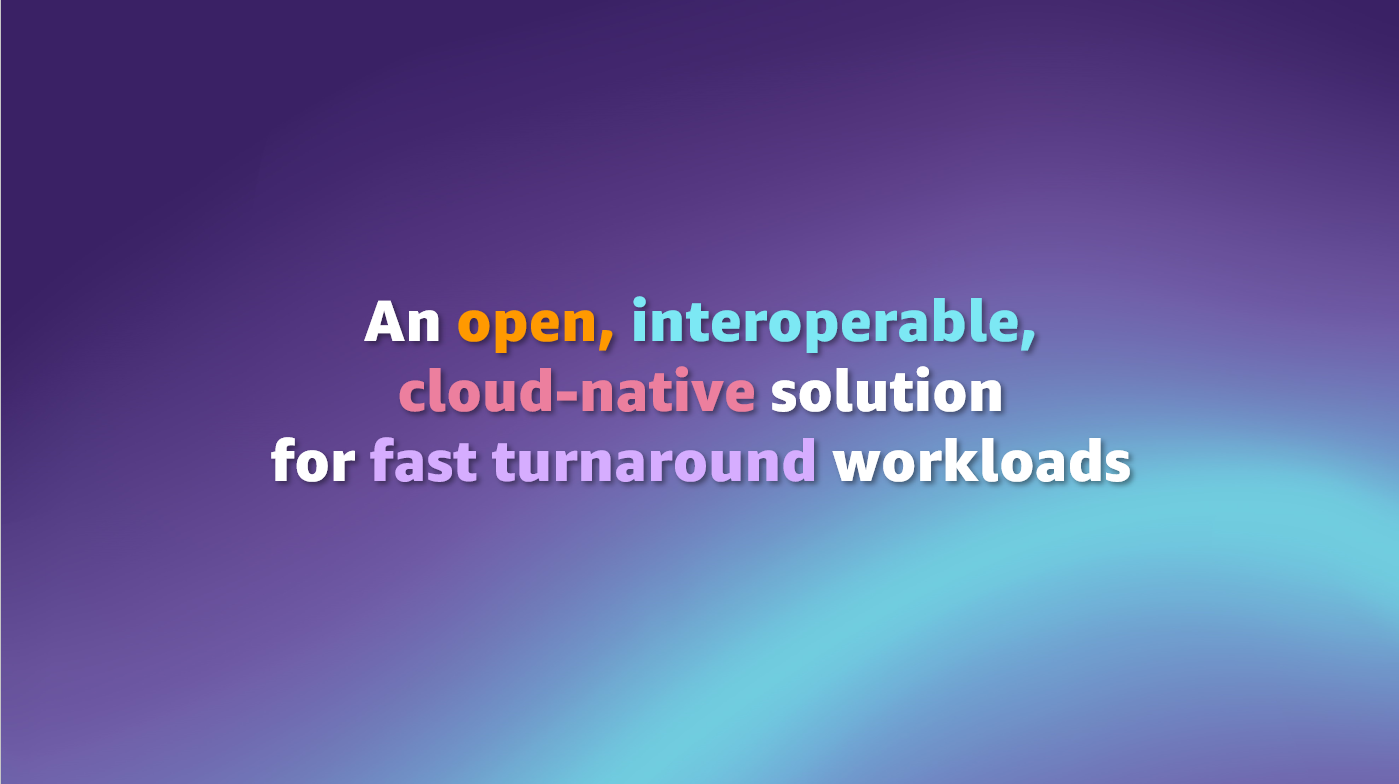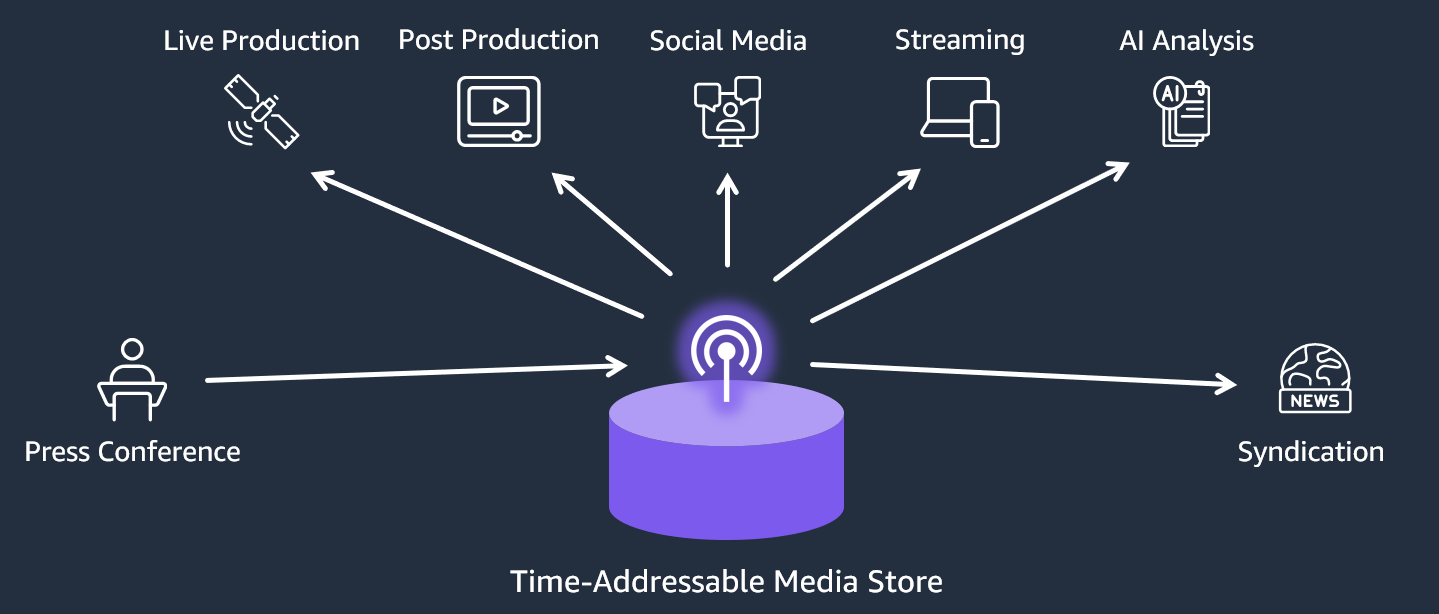Why Use TAMS?
Vision
The vision of using TAMS within the media production is to not to just look at how to lift and shift the existing ways that the media industry has been built around since it started using file-based workflows. Instead, it is an opportunity to look at how a completely different approach based on modern software architectures can be designed to re-think fast turnaround workflows.

Figure 5: Vision statement for using TAMS
There are four key areas:
The TAMS approach uses an open source specification hosted on GitHub, which means that any customer or partner can take the specification and build it into their products without needing to worry about proprietary technology or licensing fees.
Creating an ecosystem of interoperable tools that support the common TAMS API standard simplifies the process of building new workloads. Rather than needing to create custom integrations between different vendor products, if both adopt the TAMS specification, then they should be compatible both with each other and also with any other tools adopting the specification.
Thinking in a cloud-native manner means adopting modern software techniques to enable faster and easier deployment and greater flexibility. These include ensuring that tools support the use of CI/CD pipeline for deployment, as well as making sure that they support scaling with the workload and are designed to take advantage of the cloud.
While the adoption of TAMS is being driven by fast turnaround use cases, this does not stop it from being used in other use cases where live, near-live, or as-live workflows are required. In addition, there are benefits in traditional workflows to speed up tasks such as camera-to-cloud.
Customer Benefits
Using TAMS for live or near-live workflows results in the following customer benefits:
Convergence: A single TAMS store can serve multiple different purposes and business units. This includes the broadcast, post-production, social media, and VOD teams all being able to source content from a single store. Traditionally, this was often separate systems for the different teams duplicating processes and content.
Cost effective: By using cloud-based technologies and focusing on the use of commodity object storage, we remove the need for high performance file systems and de-duplicate the storage. Adding serverless technologies which scale based on usage means that using TAMS should be significantly cheaper than the traditional growing file and hardware approach.
Interoperability: With vendors adopting a common API specification, this should provide interoperability between products supporting the TAMS API, allowing customers to pick and chose the tools they want to use. If required in the future, they swap them out for other tools supporting the specification.
Open framework: The TAMS API is an open source specification. This means that any customer or partner can start building around it without needing the support of a single vendor for proprietary technology or license fees.
Bringing together live and file: TAMS is based on the same core reference architecture as Networked Media Open Specifications (NMOS). This means it’s possible to preserve both the timing and identity for content between the live and stored domains, simplifying workflows.
Elasticity: The use of the cloud and cloud-based technologies means that a TAMS solution should be able to scale both up and down with the business need. This is particularly key in live environments where the workloads are rarely constant. In sports, work often occurs on certain days or times of year, so hardware systems often have low utilization, sitting idly and waiting for the next event. While there is a typical level of day-to-day work for news broadcasters, there is always an element of unpredictability about what might happen, requiring them to react and scale quickly. Additionally, there are occasional events such as elections which require significantly more resources for a short period of time.
Workflow acceleration: The ability to access segments as soon as they are written to the store and the use of “edit by reference” workflows means that workflows can be achieved faster than traditional file-based approaches. The reduction or even complete removal of render times for edits means faster publishing and reduction in compute requirements and wasted operator time.
Use Cases
A major benefit of using TAMS is that a single store can be used across multiple different teams. They all have access to the content at the same time, as soon as a segment is written to the store. Additionally, any work done in one area, for exampling clipping content, can be available to all teams, reducing duplication of effort and media.

Figure 6: Example of use case convergence using a single TAMS instance
The following are the use cases for potential workflows based around a TAMS store. A single store could serve one or more of the use cases from a single ingest.
Fast turnaround news and sports
The primary focus of the CNAP project is the traditional news and sports workloads that require the capture of live feeds and then editing and playback while the live feed is still ongoing. Typical examples include: newsrooms requiring a live feed to be captured, clips played into the 24/7 news channel, packages created for the lunchtime, or evening news programming.Edit by reference
Most edits within the news and sports world are made up of simple clips put together with no change to most of the content within them. By storing the content as small fragments of media and referencing them to create items where the content is unchanged, editing can be done “by reference,” pointing at the original segments. Where new content is created (for example, a dissolve or adding a caption), just this section would need to be rendered and exported to the store. This process saves both time for the editor and compute resources to render, flatten, and export the content.Live to VOD
With the similarities between TAMS and formats such as HTTP Live Streaming (HLS) and Dynamic Adaptive Streaming over HTTP (DASH), it is possible to use a TAMS store to manage Live to Video on Demand (VOD) workflows. New items can be created as metadata pointers within the TAMS store to the original chunks. When combined with a TAMS to HLS endpoint, VOD assets are available immediately to the end user. For platforms which require other formats, you have the choice of transcoding each chunk to the required format and then only concatenate at the end of the recording, speeding up the process overall.Camera to cloud
The connected cameras available on the market work by creating relatively short chunks of content (30 seconds to 2 minutes) and then uploading them. While this is currently longer than some of the recommended workflows in the TAMS world (more typically 2-10 seconds), this could be used within a TAMS store. This would allow editors to receive content from a camera within minutes of it being shot on location.Reality TV shows
An advantage of a TAMS store is the strong identity and timing models, which, when combined with the chunked media approach, allows for almost infinite length records which clear and accurate timestamps. For reality TV shows with multiple cameras recording over long periods (potentially weeks), this would simplify workflows. For example, you can use single continuous records per camera rather than course 30 minute chunked recordings in addition to strong timing data to link the different recordings.Live AI analysis
AI models process files and not livestreams, so a typical workflow for live content analysis starts by capturing the feed into small media chunks on Amazon Simple Storage Service (Amazon S3) and analyzing them. This is exactly the principal behind the TAMS store. Using the new content event notifications from the TAMS store to trigger analysis means not having to build a new ingest pipeline dedicated to AI analysis. It should also allow AI solutions to focus on the analysis element rather than needing to manage the video fragments.Long distance working or distributed workforce
The cloud-native approach of a TAMS store means that all content is accessed over HTTP protocol. This breaks the traditional requirement to be able to mount the central file system onto a workstation, and therefore limits the distances involved. The use of object store over HTTP allows for technologies such as proxying, caching, or cloud delivery networks (CDNs), which allows content to be accessed over much longer distances. This allows the workforce to be distributed much more widely with the ability to still work on the single store.Multi-store and multi-location
The concept of multiple federated stores has come up a few times where content needs to be held centrally, however there is also a need for a version locally. Examples of this could be an OB truck on location with limited connectivity. By running a TAMS store locally, content could be ingested locally for security. Then, either the proxy or just chunks required should be pushed on demand to a centralized TAMS store. Once the event has finished and the truck has returned to base, then all the remaining content could be uploaded. Another example could be the LA Olympics in 2028, where a TAMS store could be located in the US West Coast for the core ingest; however, just the content required for production in Europe could be replicated to a store in a European region.Multi-company
Within the news world, there are often pooling agreements between organizations to share content for major events to reduce the cost of covering them. This means ingesting and sharing the content depending on the agreement. Work is underway to add fine-grained authorization into the TAMS specification to allow access to content in a TAMS store based on user permissions and roles. This would then allow a company to share a subset of their store with other companies who they have agreements with. The receiving company could then pull just the segments they require, as the event is ingesting rather than a whole recording once complete.Personalized content creation
There is demand for greater personalization with in the content world. To achieve this means having a whole set of media fragments that can be assembled as required. For example, an advert may have multiple different endings depending on the viewer. A TAMS store effectively holds a set of recipes for how to turn media fragments back into content and also allows re-use of the fragments across items. As such, it could be used to store personalized content, simplifying the process for downstream systems to access the different versions.Record of transmission (ROT)
Linear playout channels have a legal requirement to record and store their output for a given period of time. This is a long-term recording that needs to be continuous, but at the same time, there needs to be the ability to navigate to a given date and time to view the output and possibly export a section for reference. The strong timing data, the ability to do almost infinite length recordings, and the capability to trim by time ranges means that a TAMS store could be an ideal media store for ROT recordings.